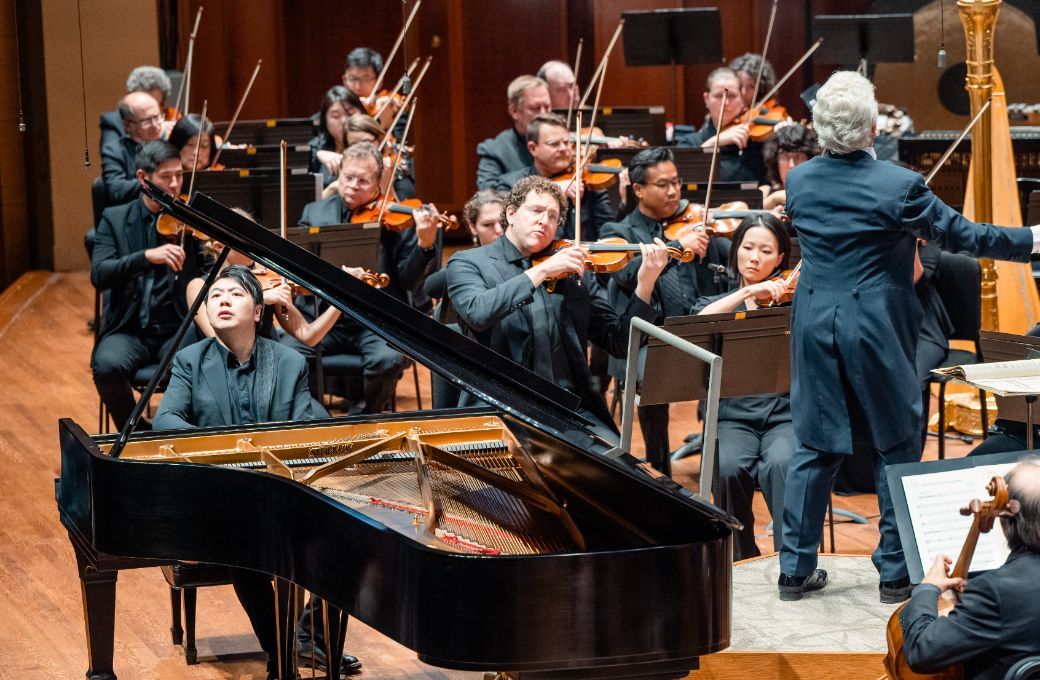“Do you know what it's like when someone invites you to ride in a great sports car and you wish you'd turned them down?” composer John Adams once asked after a terrifying foray in a souped-up Ferrari. His brief, frenzied 1986 piece Short Ride in a Fast Machine, less than five minutes long, afforded a lively opener to a Seattle Symphony concert helmed by Peter Oundjian, which included the Piano Concerto no. 2 in G minor by Camille Saint-Saëns, with incomparable showman Lang Lang, and Ottorino Respighi’s The Pines of Rome. The glittering occasion of the 25th anniversary of Benaroya Hall provided the background to this exciting program.
Short Ride, which Adams describes as a “fanfare for orchestra”, is a classic example of his post-minimalist style. The emphatic use of percussion in the score (the woodblock grabs attention from the beginning) adds to the humorous tenor of the piece. Perhaps not coincidentally, the lively opening resembles the initial phrases of Respighi’s Pines. Generous numbers of brass and woodwinds gallop along from the outset with animation, giving the fine players of those sections a chance to sparkle. Oundjian began energetically and, with nary a moment to catch his breath at that pace, kept the momentum going with skillful clarity in the fast-changing rhythms.

The thrill of Adams’ piece heightened the anticipation for the appearance of Lang Lang. His performance of Saint-Saëns’ soulful, instantly appealing work was as breathtaking as one would expect from a pianist who has superstar status. The composer himself was soloist in the 1868 premiere, but the piece was criticized for its precipitous fluctuations in style. Perhaps it was because the three movements, Andante sostenuto, Allegro scherzando and Presto, like the configuration of Beethoven’s “Moonlight” Sonata, did not follow the typical fast-slow-fast pattern of the day. After 150 years in which the Second became the most admired of the composer's piano concertos, structure seems secondary.
Lang Lang’s ability to transcend technical challenges makes his playing go beyond the notes. He is a master of contrasts: the cadenza-like first movement was somber but not tragic; the Scherzo lighter than air and seemingly as swift as the speed of light. In the fiendish Presto, he showed what he does best: virtuosic, spectacular and self-assured, but infusing each note with mature power and thoughtful insight, as if he could slow down time, yet be lightning-quick all at once. His increasingly frenetic tempi were electrifying.
With the audience pumped by such a buoyant performance, Respighi’s Pines was bound to bring down the house as the finale, giving both orchestra and conductor the opportunity to show their virtuosity. Continuing in the spirit of Fast Ride, Oundjian kept the energy alive with breakneck speed in The Pines of the Villa Borghese, with shining moments in the brass and woodwind sections, expansive ones in the Catacombs, and a particularly lovely offstage trumpet. A sweetly played clarinet solo, coupled with the perfect amount of ethereal atmosphere, evoked the gardens of the Janiculum, leading to the explosive Appian Way finale, conjuring the Roman Empire’s past glories. Oundjian conducted with grace, authority and command throughout.


